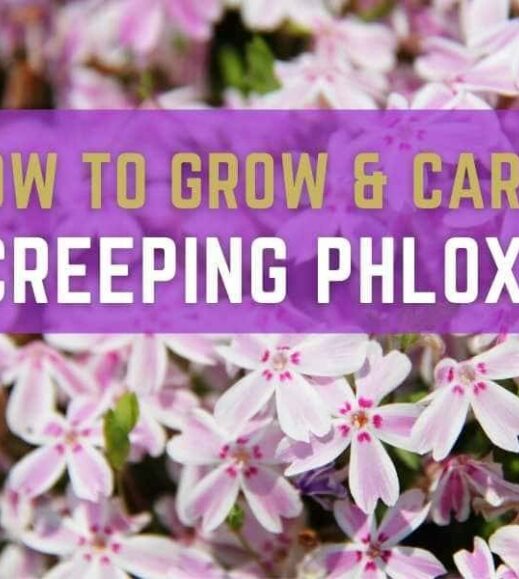Creeping phlox is a beautiful flowering plant that comes from the Polemoniaceae family. This creeping plant is native to slopes and open areas of central and eastern America. Various kinds of creeping phlox, such as Phlox stolonifera, Phlox subulata, are cultivated and used in gardens and rock gardens. We will discuss how to care for creeping phlox and grow them easily below!
The creeping phlox is a perennial herbaceous plant with spreading semi-evergreen leaves and erect clusters of large blooms. Creeping phlox is a perennial plant that will come back year after year. They like well-drained soil and full sun to partial shade.
The beautiful flowers are pink, lavender, blue, or white with an eye of purple-red tinged in white and blossoming during mid to late spring.
You should know a few things about creeping phlox before growing them.
Where To Buy Creeping Phlox?
You can purchase creeping phlox at your local nursery, garden center, or online.
There are a few different types of phlox, and each one has its unique characteristics. The three most common types of phlox are:
- Creeping phlox (Phlox subulata) (Hardiness Zones 2-8)
- Woodland phlox (Phlox stolonifera/divaricata) (Hardiness Zones 3-8)
- Garden phlox (Phlox paniculata) (Hardiness Zones 4-8)

Looking for the best app to identify any plant using your iPhone or android?
Creeping Phlox - Phlox subulata (Hardiness Zones 2-8)
Creeping phlox (Phlox subulata) carpets the rock gardens and flower beds in early spring. It makes a beautiful combination with early spring bulbs that grow above its mat-like growth habit.
It thrives in less humid conditions, blossoms best in full sun, and prefers moist, well-drained soil.
The half-inch blooms in pink, red, blue, purple, or white hues and provides pollinators with a dependable food source.
Creeping phlox is very hardy and robust and will endure for many years in the garden if you take good care! It is a smaller type of phlox that only grows up to 6 inches tall.
Its flowers are also smaller but come in a wider variety of colors, including pink, red, and white. Some of the common varieties include white delight and candy stripe.
Woodland Phlox (Phlox stolonifera / Phlox divaricata) (Hardiness Zones 3-8)
Woodland Phlox (Phlox stolonifera) They are ideal ground cover for shady locations with part shade. They're perfect for creating a low-growing ground cover in partial shade.
They bloom on three-eight-inch flowering stems. It grows in full sun or partial shade places and prefers moist soil. It should be watered regularly during dry periods.
Common varieties include Pink Ridge, Sherwood Purple, Bruce's White, Blue Ridge, and Home Fires.
Garden Phlox (Phlox paniculata) (Hardiness Zones 4-8)
Garden Phlox (Phlox paniculata) This type of phlox is most commonly cultivated and used in gardens. It blossoms in the middle of the summer. It grows fairly tall, i.e., around 18-24 inches tall, and produces large clusters of lavender, blue, or white flowers. They prefer moist soil, whereas creeping phlox (Phlox subulata) prefers drier conditions and full sun.
Phlox stolonifera vs. Phlox subulata
Phlox stolonifera is similar to Phlox subulata in that its flowers are smaller. However, its leaves are thicker and fleshier and taller than Phlox subulata. The major distinction between the two is that P. stolonifera can endure some shade, whereas P. subulata thrives exclusively in direct sunlight.
Creeping Phlox Colors
The colors of creeping phlox can vary depending on the variety. Common colors include pink, purple, white, red, lavender, and blue.
Cultivation And Historical Use
Creeping phlox can be cultivated just about anywhere. It prefers full sun to partial shade and well-drained, almost dry soil with average fertility.
It tolerates poor soils, including heavy clay, saltwater conditions, coastal areas, alkaline soils, and some degree of drought.
Since creeping phlox does well in poor soil, it is very popular for rock gardens and borders.
Creeping phlox can also be used as a ground cover or mass planting along pathways or walkways.
Creeping phlox also helps control erosion and attracts butterflies and bees.
How To Grow And Care For Creeping Phlox: Creeping Phlox
How to grow for creeping phlox?
If you want to start growing and caring for creeping phlox, you first need to purchase creeping phlox plants or seeds. You can find creeping phlox at most garden centers and online retailers.
Once you have your plants or seeds, you must choose a location. Creeping phlox prefers well-drained soil and requires full sun. They also prefer slightly acidic soil and cool or warm temperatures. They can, however, also grow in neutral or slightly alkaline soil.
Once you have chosen a location, it's time to plant your creeping phlox! Dig twice as wide as the root ball and just as deep. Place the plant in the hole, fill it with soil, and pack it down firmly. Water creeping phlox after you plant it.
.
Planting Instructions
The first step is to find out what soil you should use to grow creeping phlox. Different types of soils have different properties. For example, clay soils tend to hold moisture better than sandy soils.
Creeping phlox grows well in soil rich in organic matter and prefers slightly acidic soil (pH between 5.5-7.5). It does best in moist, rich, well-drained soil.
Care of Creeping Phlox: How To Care For Creeping Phlox?
Once you have planted your creeping phlox, it is important to water them regularly. Creeping phlox likes moist soil but not wet soil. Make sure to water them when the soil feels dry to the touch.
If you live in a cold climate, you need to care more when growing creeping phlox. They prefer cool or warm temperatures, so if it gets too cold, they may not flower. You can help keep them warm by planting them in a location that receives partial sun or using mulch to keep the soil warm. You can also use cold frames.
Creeping Phlox Propagation
The seeds should be sown in early spring after the soil has warmed up. They germinate within two weeks and can be planted directly into the garden once they sprout. If you want to start them indoors, sow them in peat pots filled with potting mix. Keep the seedlings moist but not wet.
Light
Full sun to partial shade is ideal for this plant. Flower development may be hampered by excessive shade.
Soil
The soil must be rich in organic matter for creeping phlox to thrive. It prefers slightly acidic soil pH but can survive in neutral and somewhat alkaline conditions. It also needs well-drained, moist soil.
Water
This plant prefers moderate moisture in the soil, but mature plants have some drought tolerance. Unless you receive rain, it will generally require watering once a week, especially during the summer heat.
Temperature and Humidity
Creeping phlox plants are quite hardy in their native areas. They can tolerate heat and some frost, although exposure to temperatures below 40 degrees Fahrenheit for a longer period may harm the plants.
They can tolerate a higher or lower temperature, but they may not flower as well. They prefer a humid environment but can still survive in a low-humidity area.
Fertilizer
You can use an all-purpose fertilizer or feeding mixture once or twice a year to speed up the growth.
Fertilizing in the late winter or early spring will help to promote growth and produce a better bloom of your creeping phlox. Feeding with a general slow-release fertilizer and following label instructions will help it grow better.
Mulching
Mulching creeping phlox is beneficial because it protects the plant in winter and helps retain moisture in summer. Organic mulch breaks down over time and adds nutrients to the soil, or you can choose inorganic mulches that are easier to use.
Do not pile mulch up against creeping phlox stems. It may hold in too much moisture and cause root rot. Instead, apply it around creeping phlox plants to be about 2 inches away from them.
Pruning
The pruning of creeping phlox is best done in late winter or early spring. Cut the stems back by about one-third to encourage new growth. You can also deadhead (remove) spent flowers to keep the plants looking tidy and promote more blooms.
Propagating Creeping Phlox
Creeping phlox are usually propagated by division or cuttings. You can divide creeping phlox plants in late winter or fall. Use a sharp knife and cut creeping phlox plants by about one-third before planting the divided pieces in new locations. Take 4 to 6-inch long stem cuttings in late summer or early fall and strip off the leaves from the lower 2 inches of your creeping phlox stems. Dip these stem cuttings into rooting hormones, then plant them in warm soil. The new creeping phlox plant will flourish in about 3-4 weeks.
Common Pests
The common pests in creeping phlox are aphids, spider mites, and whiteflies. These pests can be controlled with several methods, including insecticidal soaps, horticultural oils, or neem oil. Spraying the plant with forceful jets of water can help remove mites and slow their spread. Insecticidal soaps are also effective in suppressing mites, but they must be applied carefully to ensure that the pesticide is absorbed by the leaves undersides and reaches the mites.
Read more about "How To Get Rid Of Spider Mites In Your Plants."
How to Get Creeping Phlox to Bloom?
Creeping phlox typically blooms from March to April. However, you can help to promote blooms by deadheading (removing) spent flowers. You can also fertilize the plants in late winter or early spring to encourage growth and blooms. Avoid pruning your phlox until it has completed blooming to prevent removing flower buds.

Looking for easy-to-maintain, low-budget front-yard landscaping ideas?
Maintenance
Creeping phlox is a low-maintenance plant that doesn't require much care. However, you can do a few things to help keep your plants looking their best.
- Water creeping phlox regularly, but be sure not to overwater. Creeping phlox can tolerate drought conditions but will perform best with moderate watering. Watering well once a week is usually sufficient.
- Fertilize creeping phlox in late winter or early spring using a balanced fertilizer. Avoid using high-nitrogen fertilizers, which can cause the plants to grow too tall and leggy.
- Avoid pruning creeping phlox until it has completed blooming to prevent removing flower buds. If you need to prune creeping phlox, do so in late spring or early summer before the plant begins blooming again.
- Be careful not to damage creeping phlox roots when digging around them for garden maintenance, such as removing weeds or adding mulch.
Tips On Using Creeping Phlox In Your Garden
Creeping phlox is a versatile plant used in various ways in the garden. Here are some examples:
- Plant creeping phlox around the base of trees. The creeping phlox will help keep weeds out of your garden while providing attractive foliage.
- Creeping phlox is an excellent choice for rock gardens or rock borders.
- Use creeping phlox as a ground cover to prevent weeds and retain soil moisture.
- Plant creeping phlox near patio areas so you can enjoy the flowers without stepping on them.
- Plant creeping phlox under shrubs and trees to add color to the shady areas.
- The creeping varieties of creeping phlox work well in combination with other low-growing plants such as mosses or thyme.
- Make a cut flower garden using creeping phlox at various places throughout your yard. Creeping phlox blossoms make for a beautiful and long-lasting cut flower.
- Use creeping phlox as an edging plant along pathways or walkways. Creeping phlox will thrive in areas with less sunlight and help keep weeds out of the garden.
.
Creeping phlox is an excellent choice if you're searching for a low-maintenance plant to provide color and interest to your landscaping. This adaptable plant may be utilized in various ways and is drought-tolerant. You'll be happy that you planted these beautiful blooms in your yard.

The #1 guide to choosing the right houseplants for your home.
FAQs
How quickly does creeping phlox spread?
Creeping phlox can spread quickly if given the proper growing conditions.
Does creeping phlox come back every year?
Creeping phlox usually comes back every year, but there is always a chance that the plants will die off during cold winters or hot summers. If creeping phlox does not return after a year or two, it may be necessary to replant the plants.
Does creeping phlox like dry soil?
Creeping phlox can grow in almost any kind of soil. However, creeping phlox prefers moist, well-drained soil. If your creeping phlox is dying from too much drought, consider adding a layer of mulch to help reduce water evaporation and retain soil moisture. Creeping phlox also performs best with regular watering year-round.
Can creeping phlox grow in the shade? Does creeping phlox like sun or shade?
Creeping phlox can grow and flower in the shade to a partial shade. If creeping phlox are grown into the shade, they may die off. If you can, try to plant the creeping phlox in a spot that gets at least six hours of sunlight per day. If your creeping phlox is not doing well in a shady location, consider moving it to a spot with more sun.
Where is the best place to plant creeping phlox?
Creeping phlox can be planted in many different places in the garden, but it does best in locations with bright sunlight. The plant can grow in filtered shade and is preferred in well-drained, moist soil.
Does creeping phlox bloom all summer?
No, creeping phlox typically blooms in the spring and early summer. However, there is always a chance that the plants will flower later in the summer if the weather is warm.
Will creeping phlox spread on its own?
Yes, if unchecked, creeping phlox may quickly spread.
Will creeping phlox choke out weeds?
Creeping phlox makes a great ground cover for weed control. The plant can be used to edge pathways and keep weeds out of the garden.
Can you divide creeping phlox?
Yes, creeping phlox can be easily divided by a sharp shovel or spade to cut the plant into sections. Leave a few inches of stem on each section so the plant can re-root itself. Replant the divisions in well-drained soil and water thoroughly.
How do you keep phlox blooming all summer?
One way to keep creeping phlox blooming all summer is to deadhead the flowers as they start to fade. This means removing the spent flower head from the plant before it can go to seed. Another way to keep creeping phlox blooming all summer is to trim the plants back by half after they have finished flowering. This will help encourage new growth and more blooms.
When and How to Start creeping phlox seeds?
If you want to start creeping phlox from seeds, starting the plants early in the spring is best. Sow the creeping phlox seeds in a location that receives full sun and has well-drained soil. Make sure to water the seeds regularly until they germinate.
Can the Care Tips for Acoma Crape Myrtle also be Applied to Creeping Phlox?
The stepbystep care tips for Acoma Crape Myrtle may not be directly applicable to Creeping Phlox. While both plants require full sun and well-drained soil, their watering needs and pruning requirements differ. Creeping Phlox prefers slightly moist soil, and periodic pruning promotes better growth. It is essential to understand the specific care guidelines for each plant to ensure their health and beauty.
When to plant creeping phlox?
Creeping phlox can be planted in the spring or early summer. If you live in a cooler climate, you may want to consider planting creeping phlox in the fall so that it will be able to overwinter and re-bloom in the spring. Make sure to plant creeping phlox in a location that receives full sun and has well-drained soil.

How to master gardening? Download these essential home and gardening ebooks today!

















 Lalmon LLC. All rights reserved
Lalmon LLC. All rights reserved